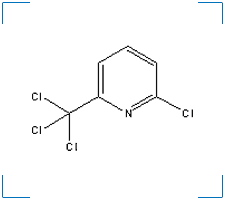Data Collection
2-Chloro-6-(Trichloromethyl)Pyridine
CAS Number: 1929-82-4
Basic Information
 Synonym(s): Donco-163; dowco-163; Nitrapyrin; Nitrapyrin ; N-Serve; N-Serve Nitrogen Stabilizer
Synonym(s): Donco-163; dowco-163; Nitrapyrin; Nitrapyrin ; N-Serve; N-Serve Nitrogen Stabilizer
Formula: C6H3Cl4N
Molecular Weight: 230.9
Boiling Point (°C): 136 - 137.5
Melting Point (°C): 62.5 - 62.9
Contaminant Type: 2-Chloro-6-(Trichloromethyl)Pyridine is a bacteriacide.
Notes: Colorless crystals
Solubility (in water)
- Solubility:
40
mg/kg
k
Temperature (°C): 22
- Solubility:
<0.01
g/100ml
d
Temperature (°C): 18
Toxicity Effects
- Organism Type:
Crustaceans
e
Common Name: Daphnia
Scientific Name: Daphnia magna
Toxicity: 10 mg/l
Test: LC0
- Organism Type:
Fish
e
Common Name: Channel catfish
Scientific Name: Ictalurus punctatus
Toxicity: 5.8 mg/l
Test: LC50
- Organism Type:
Mammals
e
Common Name: Rabbits
Scientific Name: Lagomorpha (order)
Toxicity: 500-940 mg/kg bw
Test: LD50
- Organism Type:
Mammals
e
Common Name: Mouse
Scientific Name: Muridae (Family)
Toxicity: 500-940 mg/kg bw
Test: LD50
- Organism Type:
Mammals
e
Common Name: Rat
Scientific Name: Muridae (Family)
Toxicity: 500-940 mg/kg bw
Test: LD50
- Organism Type:
Mammals
k
Common Name: Rat
Scientific Name: Muridae (Family)
Toxicity: 940 mg/kg
Test: LD50
- Organism Type:
Mammals
k
Common Name: Rat
Scientific Name: Muridae (Family)
Toxicity: 1230 mg/kg
Test: LD50
- Organism Type:
Mammals
g
Common Name: Rat
Scientific Name: Muridae (Family)
Gender: Female
Toxicity: 2140 mg/kg
Test: LD50
- Organism Type:
Molluscs
e
Common Name: Ramshorn snail
Scientific Name: Planorbis sp.
Toxicity: 10 mg/l
Test: LC0
- Organism Type:
Molluscs
e
Common Name: Ramshorn snail
Scientific Name: Planorbis sp.
Toxicity: 10 mg/l
Test: LC0
Soil Organic Carbon/Water Partition Coefficients
- Koc:
172
ml/g
k
Formulation: Batcombe silt loam
pH Value: 6.7-7.5
- Koc:
233
ml/g
k
Formulation: British Columbia silty clay loam
pH Value: 7.6
- Koc:
193
ml/g
k
Formulation: California clay
pH Value: 7.7
- Koc:
451
ml/g
k
Formulation: California loam
pH Value: 7.8
- Koc:
238
ml/g
k
Formulation: California loam
pH Value: 5.9
- Koc:
317
ml/g
k
Formulation: California sandy loam
pH Value: 7.3
- Koc:
188
ml/g
k
Formulation: California sandy loam
pH Value: 7.5
- Koc:
325
ml/g
k
Formulation: California silt loam
pH Value: 5.3
- Koc:
460
ml/g
k
Formulation: Catlin
pH Value: 6.2
- Koc:
440
ml/g
k
Formulation: Commerce
pH Value: 6.7
- Koc:
147
ml/g
k
Formulation: Minnesota loam
pH Value: 8.1
- Koc:
311
ml/g
k
Formulation: Minnesota loam
pH Value: 7.8
- Koc:
311
ml/g
k
Formulation: Texas clay
pH Value: 6.8
- Koc:
474
ml/g
k
Formulation: Tracy
pH Value: 6.2
- Koc:
2.62-2.68
k
Formulation: log
Octanol-Water Partition Coefficients
Work Cited
|
d
|
ChemFinder. Cambridge MA: CambridgeSoft Corporation. Retrieved November, 2003 from http://chemfinder.cambridgesoft.com
|
|
e
|
Verschueren, K. 1996. Handbook of Environmental Data on Organic Chemicals, 3rd edition. John Wiley & Sons, Inc., New York.
|
|
g
|
Meister, R. T., and C. Sine (Ed). 2003. Crop Protection Handbook, volume 89. Meister Publishing Company, Willoughby, OH.
|
|
k
|
Montgomery, J. H. 1993. Agrochemicals Desk Reference: Environmental Data. Lewis Publishers, Boca Raton, FL.
|